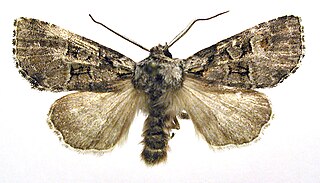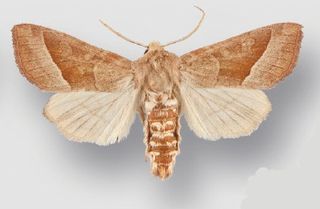
The Noctuidae, commonly known as owlet moths, cutworms or armyworms, are the most controversial family in the superfamily Noctuoidea because many of the clades are constantly changing, along with the other families of the Noctuoidea. It was considered the largest family in Lepidoptera for a long time, but after regrouping Lymantriinae, Catocalinae and Calpinae within the family Erebidae, the latter holds this title now. Currently, Noctuidae is the second largest family in Noctuoidea, with about 1,089 genera and 11,772 species. However, this classification is still contingent, as more changes continue to appear between Noctuidae and Erebidae.

The minor shoulder-knot is a moth of the family Noctuidae. The species was first described by Johan Christian Fabricius in 1776. It is distributed throughout Europe then east across the Palearctic to Siberia and Japan. It also occurs in Turkey.

Brachylomia is a genus of moths of the family Noctuidae.

Drasteria is a genus of moths in the family Erebidae.
Lomilysis was a genus of moths of the family Noctuidae. It was a monotypic genus. The single species of the genus Lomilysis discolor, is now known as Brachylomia discolor.

Apamea scoparia is a moth of the family Noctuidae first described by Kauri Mikkola, Tomas Mustelin and J. Donald Lafontaine in 2000. It is one of the most common and widespread North American Apamea, being distributed from Newfoundland and Labrador to Alaska and British Columbia, and south to California and Arizona.

Apamea apamiformis, known by the common names rice worm moth, riceworm, and wild rice worm, is a moth of the family Noctuidae. It is found in North America, including Wisconsin, New York and Minnesota.
Brachylomia populi is a moth of the family Noctuidae first described by Strecker in 1898. It is found in the inland mountains of western North America, from British Columbia and Alberta and to the south through Colorado and Utah into Arizona.

Brachylomia discinigra is a moth of the family Noctuidae first described by Francis Walker in 1856. It is found from New Brunswick to British Columbia and adjacent parts of the United States.

Brachylomia rectifascia is a moth of the family Noctuidae first described by Smith in 1891. It is found in western North America from British Columbia to central California, east to Colorado.

Brachylomia discolor is a moth of the family Noctuidae first described by Smith in 1904. It is found in the western United States from southern Idaho and southern Wyoming southward through Utah and Nevada to southern California and New Mexico.

Hydraecia obliqua is a moth in the family Noctuidae first described by Leon F. Harvey in 1876. It is found in western North America, east to the Sierra Nevada in California and the crest of the Cascade Range in Oregon and Washington. It occurs continuously on the coast north to south-western British Columbia, with a disjunct northern population at Terrace, British Columbia. The habitat consists of the riparian zone along creeks and rivers of coastal rainforests, as well as oak savanna, mixed hardwood forests and valley grasslands.

Protorthodes rufula, the rufous Quaker moth, is a moth in the family Noctuidae. The species was first described by Augustus Radcliffe Grote in 1874. It is found in western North America along the Pacific Coast, and the coastal mountain ranges from northern Washington to southern California.
Brachylomia elda is a moth of the family Noctuidae first described by George Hazen French in 1887. It is typically found west of the Rocky Mountains, from British Columbia south to California and Nevada. It was first identified at Upper Soda Springs, Siskiyou County, California.
Parabagrotis cupidissima is a species of moth in the family Noctuidae. It was described by Augustus Radcliffe Grote in 1875 and is found in North America, where it ranges from southern Vancouver Island, along the Pacific Coast states, to southern California. The habitat consists of grasslands and oak woodlands.
Parabagrotis insularis is a species of moth in the family Noctuidae. It is found in North America, where it has been recorded from southern Vancouver Island, along the Pacific Coast through California to near the border with Mexico. The species was described by Augustus Radcliffe Grote in 1876.
Brachylomia sierra is a moth in the family Noctuidae, native to North America. The species was first described by James T. Troubridge and J. Donald Lafontaine in 2007.

Hypena californica, known generally as the California cloverworm moth or western bomolocha, is a species of moth in the family Erebidae. It is found in North America, where it ranges along the Pacific Coast from Alaska to southern California. The habitat consists of moist forests and riparian areas.
Brachylomia algens is a species of cutworm or dart moth in the family Noctuidae. It is found in North America.

Brachylomia cascadia is a species of cutworm or dart moth in the family Noctuidae. It is found in North America.








